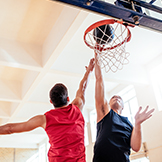
The Milwaukee Bucks are out of the bubble and in full swing. And it may not feel like it, but March is right around the corner. A lot of us suffer from basketball fever year-round. It’s also a good time to think about our own game and how we should play it safe when it’s our turn on the court. You may be wondering: What are the most common injuries in basketball? Should I be worried? MOSH is here to answer your questions and help you prevent basketball injuries.
Common Basketball Injuries
Ankle Sprains
From rolling and twisting to accidentally getting stepped on, high- and low-ankle sprains are some of the most prevalent basketball injuries. If pain, swelling and bruising occur, further evaluation may be necessary to rule out fractures or serious tears.
Jammed Fingers
A very common hand injury in basketball, jammed fingers occur when the ball contacts the end of the finger—causing significant swelling of a single knuckle or joint.
Knee Sprains, Strains & Tears
Forceful stopping, accelerating, cutting and pivoting places a lot of pressure on knee ligaments and puts them at greater risk for injury. Severe, season-ending knee injuries can include ACL, MCL and meniscus tears.
Overuse Injuries
Minor trauma to soft tissue causes overuse injuries, and it’s common with young athletes who play sports year-round without any rest in-between seasons. Shin splints, jumper’s knee (patellar tendonitis), and little leaguers’ elbow or shoulder are just a few types.
Basketball Injury Prevention Tips
- Complete a pre-season physical
- Strengthen leg muscles to better support your knees
- Warm-up with stretching prior to training or playing
- Wear supportive shoes with a higher profile around the ankle and skid-resistant soles
- Check the court for slippery spots or debris before playing
- Use proper techniques to avoid hand and wrist injuries
Your ankles, hands and knees have complex joints—making them more vulnerable to injury. If you or your child experiences a basketball injury, it’s best to seek the care of an orthopedic physician.
And of course, be mindful of social distancing and mask-wearing as best you can. Play in small groups, in well-ventilated areas. Playing on an outdoor court is ideal. Basketball can be an intimate sport; it’s key that you follow all guidelines to prevent the spread of Coronavirus.